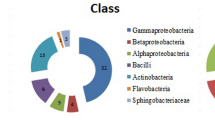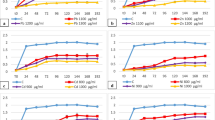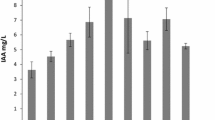Abstract
Deschampsia antarctica Desv. is the only gramineae capable of colonizing the Antarctic due to the region’s extreme climate and soil environment. In the present research, bacteria colonizing the rhizospheric soil of D. antarctica were isolated and characterized. The soil studies showed that D. antarctica possesses a wide spectrum of psychrotolerant bacteria with extensive and varied antibiotic resistance, as well as heavy metal tolerance. The bacterial strains isolated from the rhizosphere of D. antarctica also produced a diverse pattern of enzymes. Based on the strain identification with partial characterization of the 16S rRNA gene, the majority of the isolates correspond to different Pseudomonas species, and species of the genus Flavobacterium sp. and Arthrobacter sp. The isolated strains collected from this research constitute a unique collection for future, more detailed taxonomic analysis and physiological characterization, contributing to the search for potential biotechnological uses. These findings and others have great potential for developing new biotechnological products from Antarctic microorganisms.

Similar content being viewed by others
References
Aislabie JM, Chhour KL, Saul DJ, Miyauchi S, Ayton J, Paetzold RF, Balks MR (2006) Dominant bacteria in soils of marble Point and Wright Valley, Victoria Land, Antarctica. Soil Biol Biochem 38:3041–3056
Alberdi M, Bravo L, Gutiérrez A, Gidekel M, Corcuera L (2002) Ecophysiology of Antarctic vascular plants. Physiol Plantarum 115:479–486
Altschul SF, Gish W, Miller W, Myers EW, Lipman DJ (1990) Basic local alignment search tool. J Mol Biol 215:403–410
Altschul SF, Madden TL, Schaffer AA, Zhang J, Zhang Z, Miller W, Lipman DJ (1997) Gapped BLAST and PSI-BLAST: a new generation of protein database search programs. Nucleic Acids Res 25:3389–3402. Available at http://www.ncbi.nlm.nih.gov/BLAST/
Baquero F, Negri MC, Morosini MI, Blázquez J (1998) Antibiotic-selective environments. Clin Infect Dis 27:5–11
Bartholomew JW, Mittwer T (1952) The Gram stain. Bacteriol Rev 16:1–29
Beyer L, Bölter M, Seppelt RD (2000) Nutrient and thermal regime, microbial biomass and vegetation of Antarctic soils in the Windmill Islands Region of east Antarctica (Wilkes Land). Arct Antarct Alp Res 32:30–39
Blake RC, Choate DM, Bardhan S, Revis N, Barton L, Zocco TG (1993) Chemical transformation of toxic metals by a Pseudomonas strain from a toxic waste site. Environ Toxicol Chem 12:1365–1376
Bowman JP, McCammon SA, Brown MV, Nichols DS, McMeekin TA (1999) Diversity and association of psychrophilic bacteria in Antarctic sea ice. Appl Environ Microbiol 63:3068–3078
Bull AT, Goodfellow M, Slater JH (1992) Biodiversity as a source of innovation in biotechnology. Ann Rev Microbiol 46:219–252
Bull AT, Ward AC, Goodfellow M (2000) Search and discovery strategies for biotechnology: the paradigm shift. Microbiol Mol Biol Rev 46:573–606
Calormiris J, Armstrong JL, Seidler RJ (1984) Association of metal tolerance with multiple antibiotic resistance of bacteria isolated from drinking water. Appl Environ Microbiol 47:1238–1242
Casaretto JA, Serey I, Zúñiga G (1994) Size structure of a population of Deschampsia antarctica (Desv.) in Robert Island, Maritime Antarctica. Serie Científica INACH 44:61–66
Cervantes C, Gutiérrez-Corona F (1994) Cooper resistance mechanisms in bacteria and fungi. FEMS Microbiol Rev 14:121–137
Christner BC, Mosley-Thompson E, Thompson LG, Zagorodnov V, Sandman K, Reeve J (2000) Recovery and identification of viable bacteria immured in glacial ice. Icarus 144:479–485
Cowan S, Steel S (1993) Manual for the identification of medical bacteria, 7th edn. Cambridge University Press
De Souza MJ, Nair S, Loka Bharathi PA, Chandramohan D (2006) Metal and antibiotic-resistance in psychrotrophic bacteria from Antarctic Marine waters. Ecotoxicology 15:379–384
Eckford R, Cook FD, Saul D, Aislabie J, Foght J (2002) Free-living heterotrophic nitrogen-fixing bacteria isolated from fuel-contaminated Antarctic soils. Appl Environ Microbiol 68:5181–5185
Edwards J, Lewis-Smith R (1998) Photosynthesis and respiration of Colobanthus quitensis and Deschampsia antarctica Desv. from the marine Antarctic. Brit Antarct Surv Bull 81:43–63
Franke S, Gregor G, Nies DH (2001) The product of the ybdE gene of the Escherichia coli chromosome is involved in detoxification of silver ions. Microbiology 147:965–972
Goldberg M, Pribyl T, Juhnke S, Nies DH (1999) Energetics and topology of a CzcA, a cation/proton antiporter of the resistance-nodulation-cell division protein family. J Biol Chem 274:26065–26070
Grass G, Große C, Nies DH (2000) Regulation of the cnr cobalt and nickel resistance determinant from Ralstonia sp. strain CH34. J Bacteriol 182:1390–1398
Lawrence JG (2000) Clustering of antibiotic resistance genes: beyond the selfish operon. Am Soc Microbiol News 66:281–286
Levine WB, Marzluf GA (1989) Isolation and characterization of a cadmium-resistant mutant of Neurospora crassa. Can J Microbiol 35:359–365
Meargeay M, Nies D, Schlegel HD, Gerits J, Charles P, Van Gijsegem F (1985) Alcaligenes eutrophus CH34 is a facultative chemolithotroph with plasmid-borne resistance to heavy metals. J Bacteriol 162:328–334
Nichols DS, Sanderson K, Buia A, Van de Kamp J, Holloway J, Bowman JP, Smith M, Mancuso Nichols C, Nichols PD, McMeekin TA (2002) Bioprospecting and biotechnology in Antarctica. In: Jabour-Green J, Haward M (eds) The Antarctic: past, present and future. Antarctic Cooperative Research Centre, Research Report #28, Hobart, pp 85–103
Nies DH, Koch S, Wachi S, Peitzsch N, Saier MH (1998) CHR of prokaryotic proton motive force-driven transporters probably contains chromate/sulphate antiporters. J Bacteriol 180:5799–5802
Pandey KD, Shukla SP, Shukla PN, Giri DD, Singh JS, Singh P, Kashyap AK (2004) Cyanobacteria in Antarctica: ecology, physiology and cold adaptation. Cell Mol Biol (Noisy-le-Grand) 50:575–584
Peitzsch N, Eberz G, Nies DH (1998) Alcaligenes eutrophus as a bacterial chromate sensor. Appl Environ Microbiol 64:453–458
Purchase D, Miles RJ, Young TWK (1997) Cadmium uptake and nitrogen fixing ability in heavy-metal-resistant laboratory and field strains of Rhizobium leguminosarum biovar trifolii. FEMS Microbiol Ecol 22:85–93
Silver S, Phung LT (1996) Bacterial heavy metal resistance: new surprises. Annu Rev Microbiol 50: 753–789
Smith JJ, Ah Tow L, Stafford W, Cary C, Cowan D (2006) Bacterial diversity in three different Antarctic cold Desert mineral soils. Microb Ecol 51:413–421
Spring S, Schulze R, Overmann J, Schleifer KH (2000) Identification and characterization of ecologically significant prokaryotes in the sediment of freshwater lakes: molecular and cultivation techniques. FEMS Microbiol Rev 24:573–590
Tindall BJ (2004) Prokaryotic diversity in the Antarctic: the tip of the iceberg. Microb Ecol 47:271–283
Van Trappen S, Mergaert J, Van Eygen S, Dawyndt P, Cnockaert MC, Swings J (2002) Diversity of 746 heterotrophic bacteria isolated from microbial mats from ten Antarctic lakes. Syst Appl Microbiol 25:603–610
Vishniac H, Klinger J (1986) Yeasts in the Antarctic deserts. In: Megusar F, Gantar M (eds) Perspectives in microbial ecology. Proceedings of the 4th ISME, Slovene Society for Microbiology, Ljubljana, Slovenia, pp 46–51
Wery N, Gerike U, Sharman A, Chaudhuri JB, Hough DW, Danson MJ (2003) Use of packed-column bioreactor for isolation of diverse protease-producing bacteria from Antarctic soil. Appl Environ Microbiol 69:1457–1464
Williams JW, Silver S (1984) Bacterial resistance and detoxification of heavy metals. Enzyme Microb Technol 6:530–537
Zemelman R, Silva J, Henríquez M (1980) Antibiotic resistant bacteria in seawater from Concepción Bay. Arch Biol Exp 13:121
Zúñiga GE, Alberdi M, Fernández J, Montiel P, Corcuera LJ (1994) Lipid content in leaves of Deschampsia antarctica from the maritime Antarctic. Phytochemistry 37:669–672
Acknowledgements
The authors are grateful for Grants INACH No. 03-01 and Grant DIUBB 055209 2/R 2005; Convenio Desempeño II 2007 Universidad de La Frontera; to the Instituto Antártico Chileno, Ministerio de Relaciones Exteriores 2005–2007 for logistical support; and the biotechnology company Vitrogen S.A.
Author information
Authors and Affiliations
Corresponding author
Rights and permissions
About this article
Cite this article
Barrientos-Díaz, L., Gidekel, M. & Gutiérrez-Moraga, A. Characterization of rhizospheric bacteria isolated from Deschampsia antarctica Desv.. World J Microbiol Biotechnol 24, 2289–2296 (2008). https://doi.org/10.1007/s11274-008-9743-1
Received:
Accepted:
Published:
Issue Date:
DOI: https://doi.org/10.1007/s11274-008-9743-1




